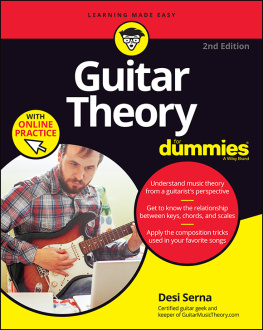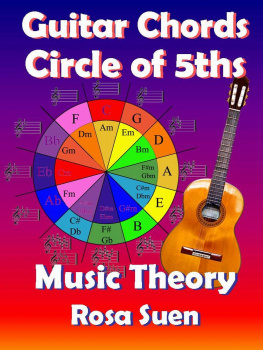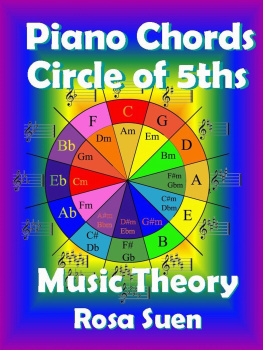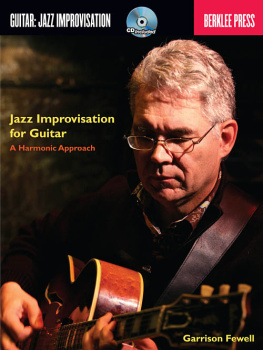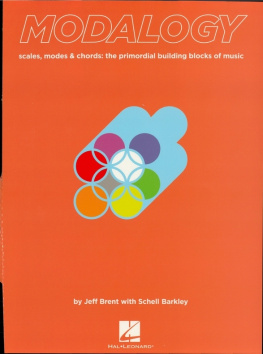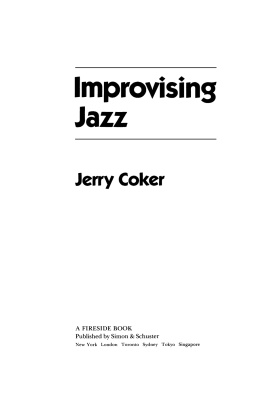
2014 All rights reserved. International copyright secured.
ISBN: 9781483540092
No part of this book may be reproduced or transmitted in any form or by any means, electronic or mechanical, including photocopying or recording, or by any information storage and retrieval system, without permission in writing from the publisher. Violation of copyright is subject to all applicable laws.
Published by Greg Fishman Jazz Studios
824 Custer Avenue, Evanston, Illinois 60202
www.gregfishmanjazzstudios.com
TABLE OF CONTENTS
Foreword
Wow! I have just finished reading through Greg Fishmans latest book The Lobster Theory (and other analogies for jazz improvisation). He should be drawn and buttered for writing this! Seriously though, I am thrilled that this book is available!
I have known Greg for a number of years and I know some of his students. I have also checked out his other books...which are all fantastic and practical and are some of the very best on the market. I find his concepts and educational approach to be holistic and he tends to use analogies and imagery to great effect. I can appreciate this on many levels. I also love using analogies and visuals when I teach and I believe it helps students think outside the box and encourages them to be more creative and visual in their musical and improvisational approaches.
What Greg has accomplished in this book is to explain, and then show - through the use of awesome drawings and complete musical examples - different concepts and ideas that are essential to our development as musicians. From Harmonic GPS and Ketchup on a Brownie to The Lobster Theory and Polishing the Silver to The Snake and Harmonic Turn Signals, The School Bell and The Bus"...Greg covers particular musical concepts in very unusual but fulfilling and exciting ways. He provides personal stories that will initially draw in students and educators, then, he provides musical examples, cartoons, and sometimes an original tune that clearly exemplify and articulate the concepts and ideas he just explained!
We all have different learning styles and varying methods we use to understand concrete as well as esoteric concepts. I feel each of these chapters acknowledges the different ways that students learn and provides a truly holistic approach to teaching. They are aural, visual and tactile all at the same time.
Greg Fishman is a great educator who has the ability to recognize that its essential to provide a variety of learning styles and patterns for the variety of ways we learn. The Lobster Theory is a really fun read and I enjoy Gregs sense of humor and wit. I truly feel the ideas he presents here are effective, long lasting and inviting for students and educators alike. I appreciate that Greg is curious, open, thoughtful, kind and honest with his students and with his approach to teaching. This is yet another in the long line of great music education books by Greg Fishman.
~ Jeff Coffin
Jeff Coffin is a three-time Grammy award winner and internationally recognized saxophonist, bandleader, composer and educator and has been traveling the globe since the late 20th Century. From 1997-2010, Coffin was a member of groundbreaking and genre-defying fusion group, Bela Fleck & the Flecktones. In mid 2008, Jeff also began touring with Dave Matthews Band after DMB founding saxophonist LeRoi Moore was injured, and officially joined the group in 2009 following his tragic passing. When not on the road with DMB, Coffin fronts his own group, Jeff Coffin & the Mutet and has presented over 300 music clinics as a Yamaha and D'Addario Performing Artist.
Preface
The Lobster Theory (and other analogies for jazz improvisation) is a new approach to learning the language of jazz. Its a book of musical concepts brought to life through the use of analogies, beautifully illustrated by New Yorker cartoonist Mick Stevens. The analogies teach complex musical ideas in a fun, friendly way, using everyday experiences from common situations.
Through these analogies I create a link between things you already know from other parts of your life, such as driving, eating, working out, etc., and show you how to use these experiences to help you achieve your goals in music.
Although music is an aural art form, not everyone has an aural learning style. All of us use our five senses (sight, sound, taste, smell and touch) to learn about the world around us.
Many people are visual learners, and they need to see an image in order to internalize a concept. Some are auditory learners, relying primarily on the sounds around them to process new information. Others are kinesthetic learners, responding to the way things feel, smell or taste.
With these different learning styles in mind, in order to make the analogies instantly relatable, I often use synesthesia, a mixing of the senses, to get my point across. For example, I might combine the sense of taste with sound, equating a flavor with a particular sound, describing a major seventh chord as a sweet apple and a diminished chord as a tart apple. Or, I may use the image of a man fishing on a lake to convert the aural concept of accented notes into a visual perspective.
Many of the analogies are lighthearted and humorous, making them very user-friendly and easy to remember. The book is designed so that the chapters stand alone. You can read it cover-to-cover, or just go directly to any chapter that appeals to you.
Throughout the book, the imaginative illustrations by Mick Stevens convey the pure essence of my analogies. This unique combination of cartoons and analogies presents advanced musical concepts in an accessible way that everyone can enjoy.
~ Greg Fishman
Credits
Written by: Greg Fishman
Illustrations by: Mick Stevens
Foreword by: Jeff Coffin
Graphic Design and Book Layout by: Susanna Helman
Edited by: Jon Ziomek and Judy Roberts
Consultant: Doug Webb
Published by: Greg Fishman Jazz Studios, Evanston, Illinois
Greg Fishman is a D'Addario Woodwind artist and plays Rico reeds exclusively.

Lifting Weights
Its January 1st, and your New Years resolution is to get in shape and start working out every day. Youve decided that youre going to do a one-hour workout each day at the gym, doing sets with a 100-pound weight. Youre making good progress, and youre developing some muscle tone. This goes great for about a week.

One day during the second week, you get busy with other things, and you miss a day at the gym. So you go in the next day, but even though the weight may look the same, it now feels like it weighs 200 pounds. You struggle with it, and you make it through the workout, but your form is getting sloppy, and youre straining.
The third week, youre just not in the mood for your workout. You miss seven days! You start feeling guilty (and you see your muscle tone disappearing), so you finally go back to the gym, ready to begin again, but now the weight feels like 700 pounds. Thats the 100 pounds you were supposed to lift each day, times the seven days you missed.

Its the same with music. As long as you practice every day, you'll improve, and you'll even build up to heavier weights represented by more challenging musical material.
Next page

